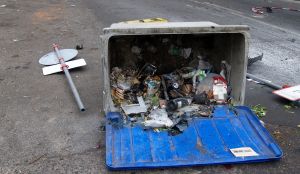
![]()
index.html>Mechanical Biological Treatment Aspects of Mechanical Biological Treatment and Waste to Energy Plants Compared
The applicant for each MBT plant must assess the potential for releases that give rise to health impacts and/or nuisance and show that the handling of residual waste within an enclosed building will minimize the potential for the pick-up and dispersion of dust from these sources. If the output from an MBT Plant is to be taken to landfill dusts can be caused in summer which are a real nuisance to local inhabitants and
may carry disease vectors. The applicant for waste plants must propose measures to prevent dusts, such as to have water supplies and bowsers
available as required to damp down haul roads and storage pads, and wheel cleaning facilities will need to be in use at the site in all wetter
weather. These problems a re less for Waste to Energy (WtoE) schemes as less sorting is needed in the plant. Waste-to-energy provides the most direct way to transform residual mixed waste into electricity. A big flagship WtoE project is proposed for Vancouver. Metro Vancouver has written to the province identifying the need to establish the biomass to fossil fuel proportion for municipal solid waste that will be considered when calculating GHG emissions in British Columbia. This is a big issue with these plants, and a relevant question. Waste to Energy plants consume power to run and additional miles for such as the refuse trucks. Flue gas scrubbing consumes more of the plant output and of course yet more fossil fuel energy is used in disposing of the spent flue scrubbing material afterwards. Yet it is still cheaper and more efficient than MBT in most cases. In a recent waste handling project some problems with occupational hygiene were identified when concentrations of microbes and endotoxins were
found to increase to levels harmful to health during waste crushing, and due to mowing this material in the bioreactor hall. Employees complained
of symptoms such as dry cough and rash or itching appearing once or twice a month, while it is advisable to use respirator masks during dusty
working phases the plants must not be built which require personnel protection equipment. Good practice in Waste Management is best served when targets are achieved through reducing the quantity of organic matter deposited, using measures such as the separate collection and recycling of the organic waste stream rather than very low quality pretreatment of residual wastes before landfilling. However, due to the unpopularity of incineration and other thermal processes on the basis that the public see them as ‘back door’ incineration, Mechanical Biological Treatment is playing, rightly or wrongly, an increasingly important role. Visit the Waste Treatment Technologies web site. for more information. |
Biomedical Waste Incineration Waste Incineration Plants Revealed Sewage Sludge Incineration Mechanical Biological Treatment Incineration and Acidity after NaoH Scrubbers Waste Water Treatment Technology for Organic Waste Disclaimer Privacy Statement |
(c) 2008 Waste Technologies Multi-Site

